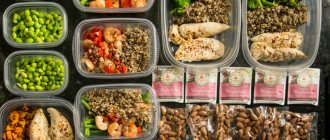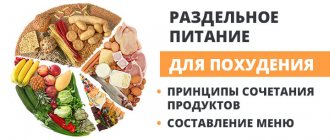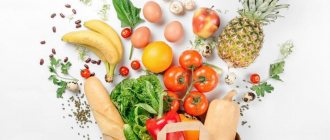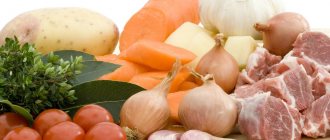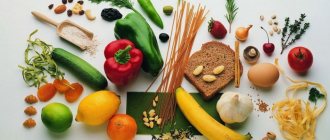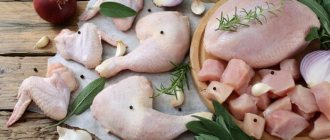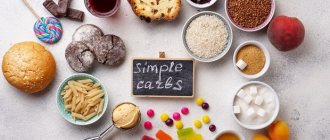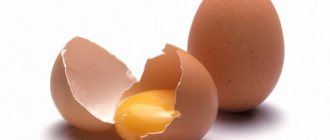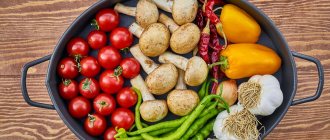Full text of the article:
Surely many have heard about separate nutrition
, but from the name it is not too clear what needs to be separated from what, and most importantly, why to do it. The philosophy of separate nutrition is that some foods are incompatible with each other, so if they enter the stomach together, it will be difficult to digest them. Only the laws of chemistry work here: protein is dissociated with the help of acids, and carbohydrates with the help of alkalis. It turns out that the stomach must have both an acidic and an alkaline environment.
Once in the stomach, incompatible products can react and cause rotting or fermentation. The stomach cannot completely digest them, so they enter the intestines unprocessed, which is an additional burden on the pancreas and the risk of intestinal upset. In addition, poorly processed foods contribute to fat storage, so people who want to lose weight often switch to separate meals.
Do nutritionists recommend separate meals?
Experienced doctors treat separate nutrition with a great deal of skepticism. They question the very essence of separate nutrition, pointing out that products are difficult to classify. There are practically no foods that contain exclusively fats, proteins or carbohydrates. Most foods contain a wide variety of nutrients. The only exceptions are refined fats and sugars.
Separate nutrition is not suitable for losing weight or treating obesity. Mono-diets suggest narrowing the diet to one product; they do not talk about the compatibility of products; a person simply eats the same thing, for example, buckwheat. Lack of variety in food reduces appetite; mono-diets are based on this idea.
If we return to separate nutrition and the theory that incompatibility of foods can cause them to rot and ferment in the stomach, then it also does not stand up to criticism. Special enzymes produced by the gastrointestinal tract must cope with all incoming food. If not enough enzymes are produced, then problems with digestion are possible, but this is a sign of the presence of a certain disease, and not the consequences of non-compliance with the principle of separate nutrition. A person should seek help from a doctor and undergo a course of treatment, and not try to solve the problem with diets or switching to separate meals.
Recipes
Knowing the principles of separate nutrition, you can easily select recipes. The advantage of this method is that you do not need to eat monotonously. There are a lot of options. Here are several recipes for the days of the cycle.
Boiled chicken
Place the prepared chicken in a saucepan and add water. Put carrots, celery, onion. The bird should be cooked over low heat. After the chicken is cooked, remove it, cool, and cut into portions. Serve cold. It is recommended to complement it with a vegetable side dish.
What to eat with separate meals
In order to independently follow the principles of separate nutrition, you need to be a good chemist and understand the composition of certain products; often the rules of separate nutrition prohibit what we have become accustomed to since childhood. For example, you cannot drink milk together with grain products; in other words, bread and milk is prohibited, since the amino acids of plant and animal proteins are absorbed differently. But there are also positive examples of compatibility: it is believed that fried meat is well complemented with plant products, since they are able to bind and remove harmful carcinogens formed during frying. At the same time, legumes should not be consumed with meat, as they reduce the absorption of animal protein.
Thus, adhering to the principles of separate nutrition is quite difficult, and its benefits have not been proven. If the digestive system works without failures, then separate nutrition will not make its work much easier. The stomach is designed to effectively process mixed food; if this does not happen, then you should look deeper for the cause and seek advice and diagnosis from a doctor.
Benefits for the body
By following the rules of separate nutrition, you can lose 10 kg.
Separate nutrition can help not only in weight loss, but also in improving the health of the body as a whole.
Dishes during the diet contain a large amount of fiber. As a result, impurities and toxins are removed.
As portions become smaller and the number of meals increases, the metabolic process accelerates.
The diet excludes fats, therefore reducing the calorie content of dishes. Which is very important for losing weight.
The amount of sugar that comes with carbonated drinks and sweet confectionery products is reduced, which undoubtedly brings benefits. As a result, weight decreases to 10 kg per month.
What products go together?
Below is a table of compatibility of products for separate feeding:
The table is constructed conveniently: we take the requested product, for example, eggs for breakfast, and see what to cook them with. Compatible foods are highlighted in green or plus: in this case, green vegetables with a low level of starch. Acceptable combinations (yellow) include sour cream and some starchy vegetables. Therefore, for breakfast we make an omelette in water with tomatoes and herbs, knowing that the products will be well absorbed.
We build the menu rationally
The food compatibility table distributes food into groups:
- Meat, poultry, fish - proper nutrition involves using lean sources of protein, so they will automatically be low in cholesterol (bad fat). Supporters of separate nutrition combine these products with herbs, onions, peppers, asparagus, spinach, and green beans to remove harmful animal fats along with fiber.
- legumes (beans, lentils) with fats (sour cream or vegetable oil), add any vegetables, which will give a boost of vegetable protein and fiber. However, potatoes are not desirable foods.
- Butter (fat sour cream and cream) is good in addition to vegetables, bread and cereals.
- Sour cream has many “friends” in the form of legumes, bread, cereals and potatoes, sour and semi-acidic fruits, tomatoes and any vegetables.
- Bakery products with cereals can be combined with sour cream, vegetable oil and legumes and vegetables.
- Sour fruits include oranges, grapefruits, lemons, kiwis, cranberries, pomegranates, tangerines, as well as sour apples and plums. This group also includes tomatoes. They go well with fats, other fruits and vegetables in salads, and as a snack with nuts and cheese.
- Semi-acid fruits include all berries, cherries, apricots, sweet plums, peaches and grapes (not green or sultanas). Combine with sour cream and sweet fruits, vegetables (green and without starch), as well as cottage cheese and nuts for a snack.
- Sweet fruits include bananas, watermelons, melons, green grapes, and all dried fruits. Combine with other fruits, herbs and dairy products.
- Non-starchy vegetables (all except carrots, beets, pumpkins, zucchini, root vegetables, squash and cauliflower) are combined with any products except milk.
- Starchy vegetables - only with fats, including nuts, breads and cereals, other vegetables, dairy products and cheeses.
Now let's go through the individual products:
- What can you eat bread when sharing meals? With fats and vegetables, and this will be a separate meal. For example, whole grain toast with sour cream and vegetable salad.
- fish with ? It belongs to protein foods and is combined only with non-starchy vegetables. It can be baked with green beans, herbs, and eaten with cucumbers and tomatoes.
- What does pasta in a healthy diet? Of course, from durum wheat. Pasta can be prepared with oils and vegetables.
- What does cottage cheese when eating separately? Mix the salad with any vegetables, sour cream, fruits and dried fruits, sprinkle with nuts. You can just have a bite with cheese.
- What to eat cheese for a snack? Can be served with cottage cheese, vegetables, berries and tomatoes. It’s easier to mix a nutritious vitamin salad of cheese, tomatoes and herbs.
- What do we eat potatoes ? Since it is a starchy vegetable, it is better to keep it to a minimum and combine it with fats, but without proteins. Thus, you will have to pamper yourself with french fries without meat, and bake without sour cream, which contains proteins.
Rice mushroom pilaf
When using the following set of products, you get 6 servings of this dish.
For a third of a kilogram of steamed rice or special rice for pilaf, you need to take 2 heads of onion and garlic, a couple of sweet peppers and carrots, 200 g of fresh champignons, vegetable oil, salt, hot pepper and water.
Cooking progress
- Cut mushrooms, peppers and carrots into equal strips. Cut the onion into half rings.
- First fry the onion until transparent, then add the carrots and fry for about 5 minutes.
- Add rice and fry for another 5 minutes.
- Pour 2 cups of hot water into a saucepan with rice and vegetables and boil everything over high heat.
- Add spices and full heads of garlic.
- Reduce the heat under the pan, cover it with a lid and simmer for about 25 minutes on the lowest heat.
- Separately fry the peppers and mushrooms.
- Place fried mushrooms in the finished pilaf and mix everything well. Sprinkle the finished dish with herbs on top.
Boiled rice with fried vegetables
To prepare 4 servings of this dish you will need the following products: for 2 cups of washed and boiled rice, take one package of deep-frozen vegetables, one medium finely chopped onion, a small amount of olive oil for frying vegetables, spices and salt to your own taste.
Cooking progress
- Remove the bag of frozen vegetables from the freezer in advance. This is necessary so that they thaw and release excess water, which will not be needed during the frying process.
- Once boiled until ready to eat, the rice needs to be strained.
- Fry finely chopped onion in a small portion of olive oil until it becomes transparent.
- Lightly salt the onion and place the defrosted vegetables in it.
- Fry vegetables for about 10 minutes.
- Add rice to the frying pan with the fried vegetables and mix well. Add spices and salt if desired.
- Fry the whole mixture a little more until the rice is heated through.
- Serve, sprinkle with chopped herbs and add butter.
Champignons (B12) + calcium
B12 was considered a vitamin found in animal products until scientists turned their attention to mushrooms. They found significant amounts of this vitamin in the pulp of champignons. In terms of biological activity, “mushroom” B12 is in no way inferior to that contained in fish and beef liver. Fresh champignons, of course, contain more of this vitamin, and we highly recommend salads and sandwiches with them. But it is relatively stable and with not particularly long heat treatment is destroyed only slightly. But vitamin B12 is very demanding of its environment. For good digestibility, it needs calcium, but under the influence of iron, copper and vitamin C it turns into a substance useless for the body. If you're on the hunt for vitamin B12, opt for cream of mushroom or julienne soup on the menu, or spread butter on bread, top it with thin slices of raw mushrooms and sprinkle the whole thing with salt and freshly ground black pepper - delicious!
Chicken with grapefruit
An unusual combination of juicy chicken meat and aromatic citrus fruit will create a real sensation. You will need:
- Chicken – 1 piece.
- Grapefruit – 2 pieces.
- Garlic – 3 cloves.
- Onions – 2 pieces.
- Dried marjoram and rosemary - 1 tablespoon each.
- Fresh marjoram and rosemary - 6 grams each.
- Vegetable oil – 3 tablespoons.
- Salt and pepper - to taste.
Cooking:
- Chop half an onion on a coarse grater. We do the same with fruit zest and garlic. In one bowl, combine these components, add dry marjoram and rosemary spices, mix everything thoroughly. Salt and pepper the resulting mass, pour in one tablespoon of olive oil and mix everything completely.
- Wash the whole chicken thoroughly, dry it with paper towels and coat the inside with pepper and salt.
- Cut the remaining onion and grapefruit into thin slices and stuff the chicken tightly.
- Place the stuffed carcass on a sheet of parchment paper spread on a baking sheet.
- Place sprigs of aromatic herbs under the chicken skin and rub with the mixture prepared at the first stage.
- We send the processed chicken to a preheated oven at a temperature of 170 degrees for 40 minutes on average.
- We regularly check the meat and water it with the resulting juices.
- In 20-30 minutes, place the remaining onion and grapefruit slices around the bird and continue baking until fully cooked.
Fish (vitamin D and calcium) and legumes + dairy products
are well familiar with such a well-known pair as calcium and vitamin D. Calcium is necessary for the healthy growth of children's bones and teeth, but even with regular intake of this mineral into the body without vitamin D, it is not absorbed. Sunbathing, fish oil or a trip to the pharmacy can save the situation.
Not everyone will eat calcium-rich fermented milk products with fatty varieties of sea fish. Show your imagination: add cheese to cod liver salads, stew mackerel in sour cream, broaden your horizons and try making Scandinavian milk-fish soup. Season legume dishes with butter, because lentils, peas and beans are real storehouses of calcium, and vitamin D is resistant to high temperatures and is not destroyed during cooking.
Types of meat and fish
Meat and fish are essential elements of human nutrition. They supply the body with useful protein, vitamins, and minerals. The fat content of foods determines how quickly they are processed by the body.
Depending on the fat content of the meat, it may take from 2 to 4 hours to process it. So lean beef will be digested in 1-2 hours, and pork in 2-4 hours. The method of preparing dishes also matters.
